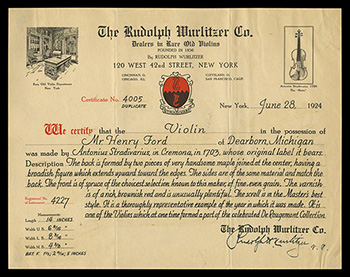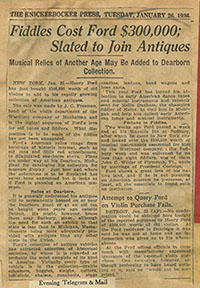| |
Shopping for Violins
One of Ford’s acquaintances was Rudolph H. Wurlitzer (1873-1948), a neighbor in a private enclave of lakeside summer homes in Harbor Beach, Michigan. Wurlitzer’s father had founded the successful Wurlitzer Company, a musical instrument business which by the early 20th century focused largely on the manufacture of automatic musical instruments and theater organs. Rudolph Wurlitzer managed the Wurlitzer Violin Department. He was widely recognized in the United States and abroad as a connoisseur of old and rare violins.
 |
Henry Ford acquired most of his classical violins through the Wurlitzer Company’s violin department. For each purchase, the company supplied a certificate describing the violin’s construction and identifying its maker. THF109929
|
Henry Ford asked Wurlitzer to send him some violins on approval. At first, Wurlitzer was reluctant to mix business with friendship—but Ford insisted. So Wurlitzer brought Ford some classical violins made by Italian master violinmakers—like the revered Antonio Stradivari—two hundred years before. Ford listened to this violin expert identify each one, and then play them. He chose several that day.
Henry would add to his personal collection over the next year, selecting those instruments whose tonal qualities best appealed to him. By January 1926, Ford had purchased a total of seven exquisite Italian-made violins. Five of these violins—crafted by Cremona’s master violinmakers during the 17th and 18th centuries—came to Ford through Wurlitzer. These five were Ford’s finest. The remaining two violins Ford purchased through Ole H. Bryant, a Boston violinmaker who served as principal repairer for the Boston Symphony Orchestra.
During the 18th century, the rich, expressive tones of fine instruments like these had filled concert halls or graced the intimate music rooms of the wealthy.
 |
The press took note of Henry Ford’s classical violin acquisitions. This Albany, New York newspaper article, published in January 1926, exaggerated the price Ford paid for his violins. (The figure was probably closer to $100,000.) But the article clearly linked Ford’s classical violin purchases to his interest in “old tunes and fiddlers.” THF109925
|
Playing Them
Ford often played his classical violins for his own enjoyment—usually scratching out tunes like “Turkey in the Straw.” A bit different, perhaps, than the classical music played on them 200 years before—but enjoyable tunes to Henry Ford nonetheless. Ford kept these violins at the Ford Engineering Laboratory in Dearborn, close at hand to his office and to his “dance room,” where Ford held his early American dances. Sometimes Ford stored the violins in a closet at his mansion, “Fair Lane,” a few miles away.
Ford was generous with his “fiddles,” allowing others to play them as well. Clayton Perry, the fiddler in “Ford’s Early American Orchestra,” sometimes played the traditional dance tunes Ford loved on the Amati and a Stradivari. When famed concert violinist Jascha Heifetz came to Detroit, Ford eagerly invited him to play the violins in Ford’s collection—then listened raptly for three hours as exquisite classical music poured forth from his “fiddles” in the hands of this virtuoso violinist.
Ford lent some of his violins to promising young violinists. Beatrice Griffin, a soloist with the Detroit Symphony Orchestra borrowed the 1709 Stradivari for a few months in late 1930. Teenaged violin prodigy Grisha Goluboff played the 1703 Stradivari from 1934 to 1938 at his performing engagements all over the United States and Europe. High school student Bruce Simpson had use of the Gagliano from 1935 to 1939, during the time he attended the private school Henry Ford operated at his Dearborn museum and historic village (now The Henry Ford).
Ford’s “Fiddling” Legacy
For Ford, violins and fiddle music were about reliving his own past. Yet—like the collections of antique vehicles, farm equipment, and cooking implements that Ford began to amass with vigor during the 1920s—violins and fiddle music were also part of Ford’s larger vision for preserving the American past. As the 19th century turned into the 20th, much of America had left this traditional music behind. But Ford never forgot it. And he wanted to share it with new generations.
Henry Ford led a nationwide revival of country fiddling and old-fashioned dancing in the mid-1920s, at the same time that he was purchasing his classical violin collection. Ford sponsored fiddling contests and hosted dances where people learned the reels, schottisches, and square dances of Ford’s youth. Many Americans joined in the fun—country dancing and fiddling swept the country for a brief time. The craze waned by the spring of 1926, as people returned to jazz-inspired popular music and more modern dances like the Charleston. (Ford’s traditional American dance revival would live on in school physical education curriculums.) But Henry would continue to enjoy fiddling and host traditional dances into the final years of his life.
Ford’s classical violins came to The Henry Ford after his death. Whether playing a country tune or performing a sophisticated classical composition—they produce an unforgettable sound.
| |
-- Jeanine Head Miller, Curator of Domestic Life
|
|

